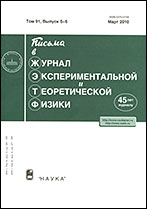|
This article is cited in 5 scientific papers (total in 5 papers)
CONDENSED MATTER
Quantum auto-ionization of molecular excitons and photovoltaic
conversion
V. A. Benderskiia, E. I. Katsbc
a Institute of Problems of Chemical Physics, Russian Academy of Sciences, Chernogolovka, Moscow region
b Landau Institute for Theoretical Physics, Russian Academy of Sciences
c Moscow Institute of Physics and Technology (State University), Dolgoprudny, Moscow region
Abstract:
This paper explores a novel way of charge separation (auto-ionization) of
molecular excitons, by quantum tunneling through nano-size p−n junction.
This mechanism can dominate the standard one (i.e., when Frenkel exciton is
ionized at donor or acceptor impurity sites)
for very short, nano-size, p−n junction, where the junction electric field can
be strong for relatively small (on the order of 1 V) voltage drop.
Within a simple one-dimensional model for the depletion region of the p−n
junction (donor and acceptor reservoirs connected by a short molecular wire)
we compute the quantum yield Yb for the tunneling exciton auto-ionization in
the “bulk” of the depletion region.
For modern organic photo-sensitive materials with p−n junction size on the
order of 10–20 nm, Yb could be close to 1.
Such a high efficiency of the charge separation (one of the main factor entering
figure of merit, indicating how good are photovoltaic conversion
cells) makes this new mechanism potentially very perspective for the
applications.
Received: 14.11.2014
Citation:
V. A. Benderskii, E. I. Kats, “Quantum auto-ionization of molecular excitons and photovoltaic
conversion”, Pis'ma v Zh. Èksper. Teoret. Fiz., 101:1 (2015), 19–23; JETP Letters, 101:1 (2015), 17–21
Linking options:
https://www.mathnet.ru/eng/jetpl4512 https://www.mathnet.ru/eng/jetpl/v101/i1/p19
|


| Statistics & downloads: |
| Abstract page: | 194 | | Full-text PDF : | 29 | | References: | 55 | | First page: | 11 |
|





 Contact us:
Contact us: Terms of Use
Terms of Use
 Registration to the website
Registration to the website Logotypes
Logotypes









 Citation in format
Citation in format 